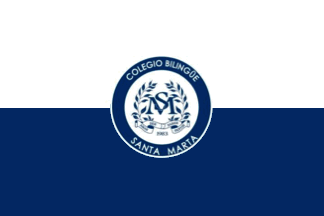 klaus-michael schneider
klaus-michael schneider
Keywords: education |
Links: FOTW homepage | search | disclaimer and copyright | write us | mirrors

Last modified: 2021-08-26 by  klaus-michael schneider
klaus-michael schneider
Keywords: education |
Links: FOTW homepage |
search |
disclaimer and copyright |
write us |
mirrors
See also:
 image by Ivan Sache, 13 September 2014
image by Ivan Sache, 13 September 2014
Institución Educativa Santa Maria was established in the Santa Maria borough,
part of the municipality of Cartagena de Indias (Bolivar Department) by the
Sisters of the Good Shepherd, a congregation founded in 1835 by the French nun
St. Mary Euphrasia Pelletier (1796-1868, canonized on 2 May 1940 by Pope Pius
XII). The congregation settled in Cartagena on 21 July 1951, with the support of
Archbishop López Umaña. One of he aims of the nuns was to provide education to
children of jailed parents. It took them 10 years to establish a first school,
Escuela Ana María Vélez de Trujillo, founded on 8 February 1961 and inaugurated
in 1962 with some 150 students. Soon transferred to new grounds, the institute
was renamed in 1964 Escuela Hogar del Buen Pastor. After the official
inauguration of the new buildings on 22 February 1965, the institute was renamed
Instituto Santa María. Decree No. 224 of 1 March 1968 renamed it Escuela Santa
María. Transferred back in 1987 to its original grounds, the institute was
renamed in 1995 Concentración Educativa Santa María.
Institución Educativa Santa Maria was eventually established by Municipal
Resolution No. 776 of 10 May 2002, incorporating Escuela Nuestra Señora de
Fátima, Escuela Marco Fidel Suárez, and Escuela Sagrado Corazón de Jesús.
Source:
http://santamaria.ieocartagena.edu.co/
The flag of the institute is horizontally divided celestial blue-white. The
upper stripe symbolizes the sky and the water that border our Caribbean
territory. The lower stripe symbolizes our aspiration to conquer and transform
our environment to live together in a world of peace and love.
Source:
http://santamaria.ieocartagena.edu.co/pagina-ejemplo/
Ivan Sache, 13 September 2014
 image by Peter Hans van den Muijzenberg, 11 April 2015
image by Peter Hans van den Muijzenberg, 11 April 2015
Institución Educativa Santa María Goretti originates in a school established
on 15 October 1933 in Mocoa (Putumayo Department) by Mother Mónica Wirth and
Sisters María Pilar Revelo, María Cornelia Greissing, María Luciana Báchtiger
and Lina Erazo. Colegio Femenino de Bachillerato Santa María Goretti was
established by Resolution No. 21 of 30 September 1967.
The institute is named for St. Maria Goretti (1890-1902; canonized on 24 June
1950 by Pope Pius XII).)
The flag of the institute is vertically divided green-white-red.
Source:
http://www.goretti.edu.co/web/index.html - Institute's website
Ivan Sache, 13 September 2014
Looks rather Italian, doesn't it? I keep wondering why these schools have
flags that are either match flags of other schools or national flags of other
nations.
I thought to shrink the white slightly, equal stripes, standard green, smaller
palette.
Peter Hans van den Muijzenberg, 11 April 2015
 image by Ivan Sache, 29 June 2014
image by Ivan Sache, 29 June 2014
Colegio Santa María Mazzarello was established in Canaguaro (Meta Department)
by the Salesian Sisters. The institute is named for St. Maria Domenica
Mazzarello (1837-1881; canonized on 24 June 1951), the founder of the Salesian
Sisters, aka Daughters of Mary Help of Christians.
The flag of the institute is horizontally divided blue-pink. Blue and pink are
the colours of the cloak and of the tunic of Mary Help of Christians. Blue
is a symbol of transcendence. Pink is the mixture of red and white. Red is a
symbol of force and sacrifice, reason and love. White is a symbol of
rectitude, transparency and strength. Accordingly, pink is a symbol of the
tenderness and kindness of the institute's patron saint.
Source:
http://colsantamariamazzarello.jimdo.com/inicio/simbolos/
Ivan Sache, 29 June 2014
 image by Ivan Sache, 07 July 2011
image by Ivan Sache, 07 July 2011
"Colegio Santa Mariana de Jesús", located in Portería (Bogotá Capital
District), is managed by the Sisters of Mariana de Jesús, a congregation founded
on 14 April 1873 by the Ecuadorian nun Blessed Mercedes de Jesús Molina
(1828-1883).
The flag of the institute is shown graphically and described on the institute's
website as horizontally divided "white-sweet red", that is pink.
Source:
http://colegiosantamarianadejesus.com/institucional.html
Pink must be the color of the Sisters of Mariana de Jesús. During the
beatification ceremony held on 1 February 1985 in Guayaquil, Pope John Paul II
called Mercedes de Jesús Molina "the Rose of Baba [her birth place] and
Guayaquil". She is locally known as "la Rosa del Guayas".
Ivan Sache, 07 July 2011
 image by Ivan Sache, 17 June 2018
image by Ivan Sache, 17 June 2018
Colegio Bilingüe Santa Marta (CBSM) was established on 3 March 1983 by
Corporacion Educative Bilingüe de Santa Marta in San Francisco urbanization,
Santa Marta (Magdalena).
The flag of CBSM is described in Article 6 of the Manual de Convivencia, as
follows:
The flag of C.B.S.M. is bicolor, composed of the white color in the upper part,
which means the immensity of the sky, and of the king blue color in the lower
part, which represents the immensity of the Caribbean Sea that water our coasts.
The flag is charged in the center with the coat of arms of C.B.S.M.
The coat of arms of CBSM is described in Article 5 of the Manual de Convivencia,
as follows:
The coat of arms of C.B.S.M. is made of a circle, which represents the
globalized world towards which we orientate our students, charged with the name
of he school. In the center of the circle are the letters "SM", which recall the
name of the institute, Santa Marta; the words "Ser, Saber, Amar y Servir" (To
Be, To Know, To Love, and To Serve) are inscribed on a scroll, which are the
base of the integral education offered to the students. This concept is
emphasized by two laurel branches that symbolize triumph, nobleness and loyalty
to our institutional principles. Beneath the graphic emblem is placed "1983",
the year of foundation of the institute.
Source:
Manual de Convivencia
Ivan Sache, 17 June 2018
 image by Ivan Sache, 12 January 2019
image by Ivan Sache, 12 January 2019
The flag of Instituto Técnico de Santander de Quilichao (Cauca Department) is
horizontally divided white-green. The white stripe symbolizes peace, purity,
kindness and the faithful reflect of pure minds, and the noble and joyous hearts
of the youth eager to learn. The green stripe reflects the immensity of the
green fields of the valley of Cauca and aspiration to a world and a life full of
satisfaction, dreams and illusions.
http://www.instecnico.edu.co/simbolos.html, School website
Ivan Sache, 12 January 2019
 image by Eugene Ipavec, 22 February 2007
image by Eugene Ipavec, 22 February 2007
The Industrial University of Santander is located in
Bucaramanga. The flag is apparently available on the home page of
the university
web site.
Ron Lahav, 22 February 2007
Simple white/green bicolor; the shade of green is
specified as PANTONE 368c, CMYK 50:0:95:0, RGB 103:185: 62.
Eugene Ipavec, 22 February 2007
From university
web site, we learn the meaning of the green colour. Green is
a bright colour symbolizing hope and a chromatic sign evoking the
opening of man towards all possible constructions, utopia, the
best for society, all implicit elements in the educative task.
Ivan Sache, 30 December 2008
 image by Ivan Sache, 1 January 2021
image by Ivan Sache, 1 January 2021
Gimnasio Santa Rocio was established in 1983 by Elisa Niño de
Chicacausa in Villa del Río borough (Bogotá).
The flag of the institute is horizontally divided white-blue.
White represents purity and liberty.
Blue represents hope, adequacy and responsibility.
Source:
http://www.gsantarocio.edu.co/gimnasio-primaria-bachillerato-bogota/Bandera-33
Ivan Sache, 26 November 2014
The flag is charged in the center with the school's emblem.
Photo
https://www.gsantarocio.edu.co/assets/images/20180719-82017-2000x928.jpg
Ivan Sache,
1 January 2021
 image by Ivan Sache, 17 December 2008
image by Ivan Sache, 17 December 2008
"Universidad Santa Rosa de Cabal" (UNISARC) is the
Colombian agronomic university. The "El Jazmin" campus
has a crop farms, a cattle farm, a fish breeding station and a
technological park.
The flag of UNISARC is shown graphically and described in the UNISARC
website.
The flag is horizontally divided yellow-green with a simplified
version of the UNISARC emblem in the middle.
The colours symbolize the balance between knowledge (represented
by yellow) and the natural environment (represented by green).
The hexagonal emblem stands for the six (economic, social,
technological, cultural, environmental and political) issues
addressed by UNISARC.
The bird, a goose displayed with spread wings, represents
progress. On the emblem, but not on the flag, red fruits placed
above the head and under the wings of the goose represent
productivity.
Ivan Sache, 17 December 2008
 image by Ivan Sache, 07 December 2014
image by Ivan Sache, 07 December 2014
Institución Técnica Agroambiental Santa Rosa de Lima is located in Cicuco
(Bolívar Department).
The institute is named for St. Rose of Lima (1642-1693, canonized on 12 April
1671 by Pope Clement X), the primary patroness of Peru and of the natives of
South America.
The flag of the institute is described in the institute's Etiquette Guidebook as
quartered green-blue per saltire. In the middle is placed a white disk
inscribing a green tree. Blue is a symbol of the water resources of the area.
Green is a symbol of the natural environment and of vegetation, and of
aspiration to a better future. White is a symbol of peace. The tree is a symbol
of the natural resources that have to be preserved for the welfare of the whole
community.
Source:
http://www.edusacx.com/santarosa/pei.pdf
Ivan Sache, 07 December 2014




